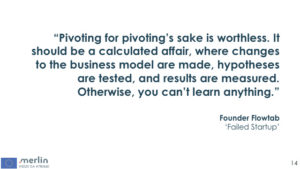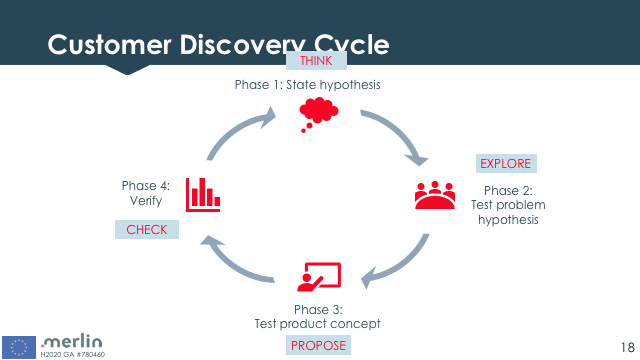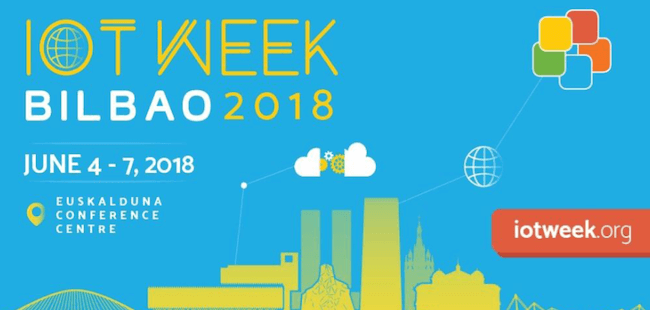The origins of the Customer Development model comes from the Stanford Lecturer Steve Blank from his observation of successful and unsuccessful businesses. The methodology relies upon the concept of the startup being a temporary organisation and that all activities are focused on hypotheses and experiments.
Customer Development and specifically Customer Discovery is important to address the main reasons as to why start-ups do not succeed.
The four steps to the epiphany refers to the complete Customer Development process. It is a method by which an entrepreneur or can discover their market, locate first customers, validate ‘guesses’ and grow the business – it starts with an entrepreneur’s vision or idea (most likely a technology) and begins to search for its market The model assumes that the entrepreneur will at least cycle 2 times through the first two, Customer Discovery and Customer Validation.
Customer Discovery answers the following questions:
- Who are my customers
- Is there a problem
- What is the market
- Can we solve it
- Can we make money off it?
Within Customer Validation the proof of success is in the generation of revenue and the completion of sales. The purpose of this cycle is to take the business model and optomise the sales process as well as exploring if the business will be profitable. The final two cycles are concerned with execution of the sales and production processes and subsequent company scaling and restructuring.
Customer validation is a key checkpoint in the process: If people aren’t buying you don’t have the right customers or your product is not the right solution.
Customer Discovery and Customer Validation have similar cycles to Lean Startup, with Lean Startup focused on product development not customer i.e. these are complimentary models not mutually exclusive. In fact, Lean Startup is inspired by Customer Development.

The open-source operating system Android is an example of a pivot. The startup was in 2003, with the intention of building an operating system for cameras. Its initial vision was to create an ecosystem of smart cameras which connected to PCs and from there linked to Android-powered data centres to offer cloud storage for photos. They saw that there was no market with the decline of the camera and pivoted to a mobile phone OS – then they were bought by Google.
In terms of Customer Discovery, it is about answering the following questions:
- Should I build it?
- Who are my customers?
- What is my market?
- Does my problem exist?
Customer Discovery is not a once-off activity – it should be seen as the first step in any new venture or project within the company.
“Founders need to be honest in their self-assessment of whether they are in love with the problem or the solution. We often see entrepreneurs who are in love with their solution focusing on the technological feasibility of the product, but who ignore the user feedback that is critical to establishing whether the customer wants their product at all.”
The four phases of the customer discovery step, through which founders are expected to through 2-4 times are:
- State your hypotheses: Write down your core business assumptions in a set of briefs. These form the basis for subsequent testing.
- Test your hypotheses: Seek validation for your hypotheses. Speak to those in and around your target market, including potential customers, analysts and the media.
- These should not be sales-oriented conversations.
- Test your product concept: Once you have a deeper understanding of the customer problem, test your product idea to get a sense of the relevance and attractiveness of your product solution and its features. Do this by engaging potential customers and sharing information with your product development team
- For web or app = rough MVP, very-rough to survive first contact.
- For services or physical = product presentation or mock-up
- Evaluate customer feedback and determine next steps: Reflect on the information obtained in phases 2 and 3. Are you ready to move forward with what you have? If not, you may need to conduct another iteration of problem/solution validation or halt the project.
The central thesis to the Customer Discovery process is: “What is the smallest or least complicated problem that the customer will pay us to solve?” with the ultimate goal of reaching a single page feature list. The business model developed in Customer Discovery is not the eventual model of the company, but will be somewhat proven, however, business models should never be seen as static as the business grows or the market changes.
The main outcomes of the process are:
- Reduced risk of market-failure
- A more efficient product development
- Constrained cash burn-rate – identify what is important or will work before investing the capital
- Improved investment potential – evidence of market demand and what won’t work and viable numbers and capital requirements
- Initial customer pipeline – don’t confuse customer discovery with sales (customer validation) however it is likely that you will be able to convert a chunk as they have invested in you journey along the way.
- A healthy dose of realism.


Recent Comments